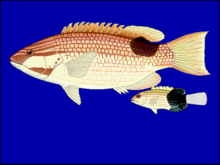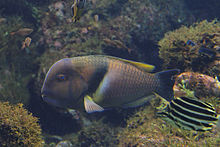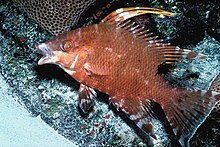Teeth wrasse
| Teeth wrasse | ||||||||||||
|---|---|---|---|---|---|---|---|---|---|---|---|---|

|
||||||||||||
| Systematics | ||||||||||||
|
||||||||||||
| Scientific name | ||||||||||||
| Hypsigenyinae | ||||||||||||
The Zahnlippfische (Hypsigenyinae) are a subfamily of the wrasses (Labridae). Some authors regard them only as a tribe (then Hypseginyini), but are then paraphyletic , since the Odacini tribe belongs to the Hypseginyae. They got their German name because of their impressive, often with protruding teeth. The large-scaled and loud-mouthed fish are also called pig wrasse.
features
Males and females in the lipfish are usually the same or similar in color, but young fish often differ significantly from adult animals. Among the lipfish there are small forms of only 10 centimeters in length, but also large species with lengths of up to one meter.
They mostly eat benthic , hard-shelled invertebrates such as crabs , mussels , snails and sea urchins .
Systematics
Phylogenetically , the pig wrasse are the sister group of all other wrasses including the parrotfish (Scarinae). In the classical system, the Odacini phylogenetically within the pig wrasse were mostly managed as an independent family.
|
Cladogram of the probable relationships between the lipfish
|
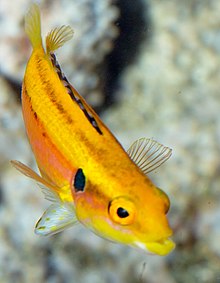
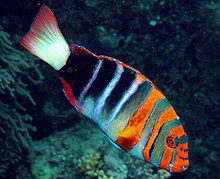
Genera and species
- Genus Achoerodus Gill , 1863
- Achoerodus gouldii (Richardson, 1843)
- Achoerodus viridis (Steindachner, 1866)
- Genus Anchichoerops Barnard, 1927
- Anchichoerops natalensis (Gilchrist & Thompson, 1909)
- Genus Bodianus Bloch , 1790
- Duke pig wrasse ( Bodianus anthioides ) (Bennett, 1832)
- Axillary pig wrasse ( Bodianus axillaris ) (Bennett, 1832)
- Bodianus bathycapros Gomon, 2006
- Bodianus bennetti Gomon & Walsh, 2016
- Bodianus bilunulatus ( Lacépède , 1801)
- Two-spotted pig wrasse ( Bodianus bimaculatus ) Allen, 1973
- Bodianus busellatus Gomon, 2006
- Bodianus cylindriatus (Tanaka, 1930)
- Diana pig wrasse ( Bodianus diana ) (Lacépède, 1801)
- Bodianus dictynna Gomon, 2006
- Mexican pig wrasse ( Bodianus diplotaenia ) (Gill, 1862)
- Bodianus eclancheri ( Valenciennes , 1846)
- Bodianus flavifrons Gomon, 2001
- Bodianus frenchii (Klunzinger, 1880)
- Bodianus hirsutus (Lacépède, 1801)
- Bodianus izuensis Araga & Yoshino, 1975
- Bodianus leucosticticus (Bennett, 1832)
- Black- fin pig wrasse ( Bodianus loxozonus ) (Snyder, 1908)
- Bodianus macrognathos (Morris, 1974)
- Bodianus macrourus (Lacépède, 1801)
- Bodianus masudai Araga & Yoshino, 1975
- Black wedge pig wrasse ( Bodianus mesothorax ) ( Bloch & Schneider , 1801)
- Neill's pig wrasse ( Bodianus neilli ) (Day, 1867)
- Bodianus neopercularis Gomon, 2006
- Bodianus opercularis (Guichenot, 1847)
- Bodianus oxycephalus (Bleeker, 1862)
- Bodianus perditio ( Quoy & Gaimard , 1834)
- Bodianus prognathus Lobel, 1981
- Cuban pig wrasse ( Bodianus pulchellus ) ( Poey , 1860)
- Bodianus rubrisos Gomon, 2006
- Spanish pig wrasse ( Bodianus rufus ) ( Linnaeus , 1758)
- Bodianus sanguineus ( Jordan & Evermann, 1903)
- Bodianus scrofa ( Valenciennes , 1839)
- Bodianus sepiacaudus Gomon, 2006
- Bodianus solatus Gomon, 2006
- Bodianus speciosus (Bowdich, 1825)
- Bodianus tanyokidus Gomon & Madden, 1981
- Bodianus thoracotaeniatus Yamamoto, 1982
- Bodianus trilineatus (Fowler, 1934)
- Bodianus unimaculatus ( Günther , 1862)
- Bodianus vulpinus ( Richardson , 1850)
- Genus Choerodon Bleeker, 1849
- Anchor lipfish ( Choerodon anchorago ) ( Bloch , 1791)
- Choerodon aurulentus Gomon, 2017
- Azure lipfish ( Choerodon azurio ) ( Jordan & Snyder, 1901)
- Choerodon balerensis Herre, 1950
- Choerodon cauteroma Gomon & Allen, 1987
- Purple-toothed lipfish ( Choerodon cephalotes ) ( Castelnau , 1875)
- Choerodon cypselurus Gomon, 2017
- Blue tooth lipfish ( Choerodon cyanodus ) (Richardson, 1843)
- Harlequin wrasse ( Choerodon fasciatus ) (Günther, 1867)
- Choerodon frenatus Ogilby , 1910
- Choerodon gomoni Allen & Randall, 2002
- Graphic toothed lipfish ( Choerodon graphicus ) (De Vis, 1885)
- Choerodon gymnogenys (Günther, 1867)
- Jordan's lipfish ( Choerodon jordani ) (Snyder, 1908)
- Choerodon margaritiferus Fowler & Bean , 1928
- Choerodon melanostigma Fowler & Bean, 1928
- Coinbearing-Zahnlippfisch ( Choerodon monostigma ) Ogilby, 1910
- Choerodon oligacanthus (Bleeker, 1851)
- Choerodon oligocanthus (Bleeker, 1851)
- Choerodon palawanensis (Seale, 1910)
- Choerodon paynei (Whitley, 1945)
- Choerodon robustus ( Günther , 1862)
- White-throated lipfish ( Choerodon rubescens ) (Günther, 1862)
- Black-spotted lipfish ( Choerodon schoenleinii ) ( Valenciennes , 1839)
- Choerodon skaiopygmaeus Gomon, 2017
- Choerodon sugillatum Gomon, 1987
- Venus lipfish ( Choerodon venustus ) (De Vis, 1884)
- Red-striped lipfish ( Choerodon vitta ) (Ogilby, 1910)
- Zamboanga lipfish ( Choerodon zamboangae ) (Seale & Bean, 1907)
- White-banded lipfish ( Choerodon zosterophorus ) (Bleeker, 1868)
- Genus Clepticus Cuvier, 1829
- Clepticus africanus Heiser, Moura & Robertson, 2000
- Clepticus brasiliensis Heiser, Moura & Robertson, 2000
- Creole wrasse ( Clepticus parrae ) (Bloch & Schneider, 1801)
- Genus Decodon Günther, 1861
- Decodon grandisquamis (Smith, 1968)
- Decodon melasma Gomon, 1974
- Decodon pacificus (Kamohara, 1952)
- Decodon puellaris (Poey, 1860)
- Genus Lachnolaimus Cuvier , 1829
- Boar wrasse ( Lachnolaimus maximus ) Cuvier, 1829
- Genus Polylepion Gomon, 1977
- Polylepion cruentum Gomon, 1977
- Polylepion russelli (Gomon & Randall, 1975)
- Genus Pseudodax Bleeker , 1861
- Chisel-tooth wrasse ( Pseudodax moluccanus ) ( Valenciennes , 1840)
- Genus Semicossyphus Günther, 1861
- Semicossyphus darwini (Jenyns, 1842)
- Semicossyphus pulcher (Ayres, 1854)
- Semicossyphus reticulatus (Valenciennes, 1839)
- Genus Xiphocheilus Bleeker, 1857
- Xiphocheilus typus Bleeker, 1857
- Tribe Odacini
- Genus Haletta Whitley, 1947
- Genus Heteroscarus Castelnau , 1872
- Genus Neoodax Castelnau, 1875
- Genus Odax Valenciennes in Cuvier & Valenciennes, 1840
- Genus Olisthops Richardson, 1850
- Genus Siphonognathus Richardson, 1858
literature
- Helmut Debelius , Rudie H. Kuiter : Wrasse . Ulmer Verlag, Stuttgart 2002, ISBN 3-8001-3973-1 .
- Ewald Lieske, Robert F. Myers: Coral fish of the world . Year publisher, 1994, ISBN 3-86132-112-2 .
Individual evidence
- ↑ Vikram B. Baliga, Chris J. Law: Cleaners amongst wrasses: phylogenetics and evolutionary patterns of cleaning behavior within Labridae. Molecular Phylogenetics and Evolution, October 2015, doi: 10.1016 / j.ympev.2015.09.006

